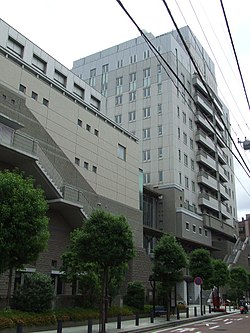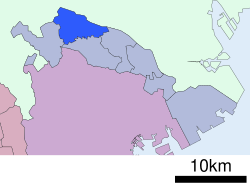Tama-ku, Kawasaki
This articleneeds additional citations forverification.(February 2012) |
Tama
Đa ma khu | |
|---|---|
| Tama Ward | |
 Tama Ward Office | |
 Location of Tama inKanagawa Prefecture | |
| Coordinates:35°37′11″N139°33′43″E/ 35.61972°N 139.56194°E | |
| Country | Japan |
| Region | Kantō |
| Prefecture | Kanagawa |
| City | Kawasaki |
| Established | April 1, 1972 |
| Area | |
| • Total | 20.49 km2(7.91 sq mi) |
| Population (March 2010) | |
| • Total | 211,221 |
| • Density | 10,310/km2(26,700/sq mi) |
| Time zone | UTC+9(Japan Standard Time) |
| - Tree | Flowering Dogwood,Nashi Pear |
| - Flower | Viola,Peach |
| Address | 1775-1 Noborito, Tama-ku Kawasaki-shi, Kanagawa-ken 214-8570 |
| Website | www |
Tama-ku(Đa ma khu)is one of the sevenwardsof the city ofKawasakiinKanagawa Prefecture,Japan. As of 2010, the ward has an estimatedpopulationof 211,221 and apopulation densityof 10,310 persons per km2.The total area is 20.49 km2.
Geography[edit]
Tama Ward is located in eastern Kanagawa Prefecture, in the far northeastern corner of the city of Kawasaki, bordering on Tokyo. It is bordered to the north by theTama River
Surrounding municipalities[edit]
- Takatsu-ku, Kawasaki
- Miyamae-ku, Kawasaki
- Asao-ku, Kawasaki
- Setagaya-ku, Tokyo
- Chōfu, Tokyo
- Komae, Tokyo
- Inagi, Tokyo
History[edit]
The area around present-day Tama Ward has been inhabited for thousands of years. Archaeologists have foundkofunalong the banks of the Tama River and at other locations in the Ward. Under theNara periodRitsuryōsystem, it was divided between Tachibana District, Tama District and Tsutsuki District inMusashi Province.By theHeian periodit was part of ashōencontrolled by the Inage clan. By theKamakura period,it was controlled by their descendants, the Ozawa clan, and in theMuromachi periodby the Terao clan. During theSengoku period,the area was a contested territory between theUesugi clanand theLater Hōjō clanfromOdawara,who emerged in control by 1530. The area was devastated by flooding when the Tama River shifted course to the north in 1590. After the defeat of the Hōjō at theBattle of Odawara,the territory came under the control ofTokugawa Ieyasu.It was administered astenryōterritory controlled directly by theTokugawa shogunate,but administered through varioushatamoto.From 1725, the 52 villages of the area were a designated zone forFalconryby the Tokugawa shōguns, but suffered from repeated natural disasters: an earthquake in 1782, floods in 1786, famine in 1787, floods in 1790, 1791 and 1809 andearthquake in 1855.
After theMeiji Restoration,the area was transferred to the newKanagawa Prefecture,and divided into several villages within Tachibana District and Tsuzuki District, Kanagawa on April 1, 1889. These areas were annexed by the neighboring city of Kawasaki from 1938 to 1939. The area became Tama Ward with the division of the city of Kawasaki into wards from April 1972. In July 1982, Asao Ward was separated from Tama Ward. A new Ward Office was completed in 1997.
Economy[edit]
Tama Ward is largely a regional commercial center andbedroom communityfor central Kawasaki and Tokyo. Several factories producing chemical, glass, and electronics are located in the ward, and there is some residual agriculture (primarily horticulture and market vegetables).
Transportation[edit]
Rail[edit]
- JR East-Nambu Line
- Keiō Corporation–Keiō Sagamihara Line
- Odakyu Electric Railway–Odakyū Odawara Line
Highways[edit]
Prefecture roads[edit]
- Kanagawa Prefectural Road 3
- Kanagawa Prefectural Road 9
- Kanagawa Prefectural Road 13
- Kanagawa Prefectural Road 124
Local attractions[edit]


- Nihon Minka-en Museum
- Taro Okamoto Museum of Art
- Yomiuriland
- Fujiko F. Fujio Museum[1]
Education[edit]
This sectionneeds expansion.You can help byadding to it.(July 2019) |
Tertiary:
- Senshu University– Ikuta campus
- Meiji University– Ikuta campus
- Japan Women's University– Nishiikuta campus
Municipal junior high schools:[2]
- Ikuta ( sinh điền trung học giáo )
- Inada (Đạo điền trung học giáo)
- Masugata (枡 hình trung học giáo )
- Minamiikuta (Nam sinh điền trung học giáo)
- Minamisuge (Nam gian trung học giáo)
- Nakanoshima (Trung dã đảo trung học giáo)
- Suge (Gian trung học giáo)
Municipal elementary schools:[3]
- Higashi Ikuta ( đông sinh điền tiểu học giáo )
- Higashi Suge ( đông gian tiểu học giáo )
- Ikuta ( sinh điền tiểu học giáo )
- Inada (Đạo điền tiểu học giáo)
- Minami Ikuta (Nam sinh điền tiểu học giáo)
- Minami Suge (Nam gian tiểu học giáo)
- Mita ( tam điền tiểu học giáo )
- Nagao (Trường vĩ tiểu học giáo)
- Nakanoshima ( trung dã đảo tiểu học giáo )
- Nishi Suge ( tây gian tiểu học giáo )
- Noborito ( đăng hộ tiểu học giáo )
- Shimofuda (Hạ bố điền tiểu học giáo)
- Shukugawara ( túc hà nguyên tiểu học giáo )
- Suge ( gian tiểu học giáo )
Private primary and secondary
Notable people from Tama Ward[edit]
- Koji Miyoshi,Football player
- Shigefumi Matsuzawa,politician
- Hikaru Nishida,actress
- Yūji Oda,actor
- Takayuki Ohira,engineer, inventor
References[edit]
- ^"Fujiko·F·Fujio Museum, in Kawasaki-city | xuyên kỳ thị đằng tử ・F・ bất nhị hùng ミュージアム".
- ^"Đa ma khu の trung học giáo nhất lãm".Kawasaki Combined Education Center.Retrieved2022-12-27.
- ^"Đa ma khu の tiểu học giáo nhất lãm".Kawasaki Combined Education Center.Retrieved2022-12-27.


